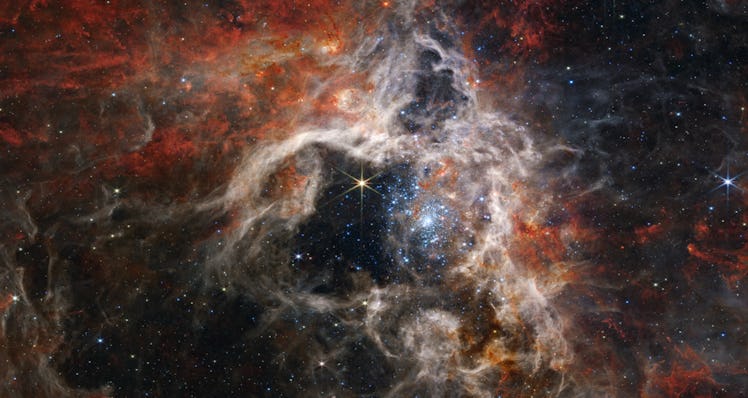JSWT's Stunning Images Of The "Tarantula Nebula" Could Help Show How Stars Are Born
The James Webb Space Telescope has returned another incredible image, this time of a star-forming region known as the Tarantula Nebula.

The James Webb Space Telescope (JWST) has done it again! The super high-tech telescope has returned another incredible image, this time of a star-forming region known as the Tarantula Nebula. The image is beautiful, but its discovery is also going to help advance space science, too. Here’s what you need to know.
According to NASA, the JWST returned images from a never-before-seen star spotted in the “stellar nursery called 30 Doradus.” This area — which is 161,000 light years away — has been nicknamed Tarantula Nebula because of the “dusty filaments” first seen in previous images taken by the telescope. But the new images from the telescope show the fabulous nebula in extraordinary detail.
“The region takes on a different appearance when viewed in the longer infrared wavelengths detected by Webb’s Mid-infrared Instrument (MIRI),” NASA explains. “The hot stars fade, and the cooler gas and dust glow. Within the stellar nursery clouds, points of light indicate embedded protostars, still gaining mass. Shorter wavelengths of light are absorbed or scattered by dust grains in the nebula.”
The telescope has been able to “penetrate the dust” around the nebula which allows scientists to see beyond, “revealing a previously unseen cosmic environment.” But even if you know nothing about space, the image is stunning, both for the color and the intricate details between all the particles.
But it’s beauty isn’t the only reason this area is of interest to astronomers. NASA explains that this nebula has a similar chemical composition to other star-forming regions in the universe. It produces star formation at a different rate than our own Milky Way galaxy.
“This makes the Tarantula the closest (i.e., easiest to see in detail) example of what was happening in the universe as it reached its brilliant high noon,” NASA wrote. And now with the JWST’s capabilities, astronomers will be able to look closer at how star formation works.
“Despite humanity’s thousands of years of stargazing, the star-formation process still holds many mysteries – many of them due to our previous inability to get crisp images of what was happening behind the thick clouds of stellar nurseries,” NASA writes.
Space science is really cool.
This article was originally published on